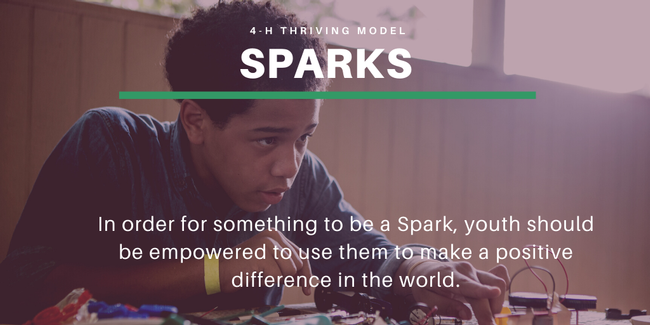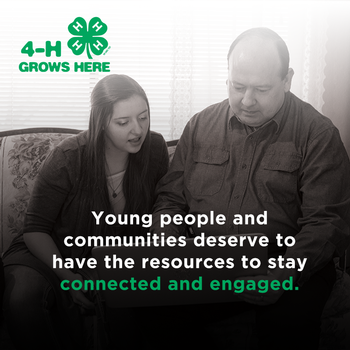4-H Thrive Reources For Volunteers
The 4-H Thriving Model
The 4-H Thriving Model describes the processes that we use to support positive youth development in 4-H. Creating and sustaining high quality developmental contexts in 4-H programs and designing activities that promote thriving are key to 4-H youth achieving developmental outcomes.
This model was developed by Dr. Mary Arnold of Oregon State University is now being tested and adopted in states across the country as our 4-H theory of change. The national 4-H Thriving Model website shares the ongoing work and development of the model, including presentations, publications and graphics.
The 4-H Thriving Model builds on our existing understanding and practice and incorporates new evidence to further describe how 4-H helps young people thrive. Here are some resources to help you explore the model. We’ll continue to add to this as we learn more about how the model is relevant for our programs and youth, where there are questions and gaps, and how we can all contribute to the research around this effort.
Positive Youth Development and the Science of Learning and Development
Defining PYD and why it works magic with youth
https://www.atchison.k-state.edu/4-h/4-_h_thiving_model/youth_thriving.html
Did you know there is science behind the magic of 4-H? Research in the fields of positive youth development and the science of learning and development (SoLD) provides the body of evidence that undergirds why what we do in 4-H positively impacts youth development. In this video Dr. Mary Arnold presents three definitions of positive youth development (PYD) and explains how PYD research is translated into practice. Also covered are the recent findings from research in the science of learning and development (SoLD) that has expanded our understanding of how youth grow and develop, and the implications of SoLD for ensuring equity and opportunity for all youth in 4-H.
Understanding 4-H Magic Video # 1
4-H Thriving Model Video Series
Defining PYD and why it works magic with youth
Did you know there is science behind the magic of 4-H? Research in the fields of positive youth development and the science of learning and development (SoLD) provides the body of evidence that undergirds why what we do in 4-H positively impacts youth development. In this video Dr. Mary Arnold presents three definitions of positive youth development (PYD) and explains how PYD research is translated into practice. Also covered are the recent findings from research in the science of learning and development (SoLD) that has expanded our understanding of how youth grow and develop, and the implications of SoLD for ensuring equity and opportunity for all youth in 4-H.
4-H Theory of Change – How 4-H works its magic with youth
How does 4-H work its magic with youth? In this video, Dr. Mary Arnold presents an overview of the 4-H Thriving Model, which describes the process of positive youth development (PYD) in 4-H programs. The model has three components: (1) Creating effective developmental contexts for youth; (2) promoting youth thriving; and (3) achieving PYD outcomes. Dr. Arnold explains the model’s background and purpose, and the testing that has been done on the model. Participants will learn how PYD is expressed in the social, emotional, cognitive and behavioral development of youth, also known as “thriving.” Dr. Arnold also shares how other 4-H frameworks, such as Targeting Life Skills and the Essential Elements are embedded in the 4-H Thriving model.
4-H Theory of Action – Practicing the magic of positive youth development in 4-H
How do we practice the magic the magic of 4-H? In this video, Dr. Mary Arnold highlights the important foundations for practice gleaned from the Science of Learning and Development (SoLD) and shares the SoLD Principles for Equitable Whole Child Design. Dr. Arnold then shows how these principles align with the 4-H Thriving Model, illustrating how 4-H programs put science into effective practice. The video then outlines six principles for 4-H programming
4-H Plays an Important Role for Young People
The continuing research on positive youth development has documented the important role that youth development programs like 4-H play in the lives of young people.
Our 4-H program embraces the concepts of
- Developing Sparks,
- Focus on quality with an emphasis on belonging, and
- Foster strong developmental relationships.
These are all part of the 4-H Thriving Model of Positive Youth Development. This model predicts that youth who participate in 4-H programs that provide a high-quality developmental context will thrive. Thriving youth achieve key developmental outcomes.
4-H Thriving Model of Positive Youth Development
Sparks
Sparks are an essential ingredient of thriving.
Having at least one spark gives youth a sense of direction and purpose and encourages goal development skills.
Sparks are not just something that makes you happy—they create the internal fuel for a young person’s growth in knowledge and skill.
Sparks help young people create a network of supportive others, especially adults with expertise who can help them grow their Spark.
Importantly, in order for something to be a Spark, youth should be empowered to use them to make a positive difference in the world.
Belonging
Youth need to know they are cared about by others and feel a sense of connection to others in the group.
It is important to provide youth the opportunity to feel physically and emotionally safe while actively participating in a group. Create a safe and inclusive environment and foster a positive relationship with youth learners. Use discussion questions that encourage youth to learn from each other, synthesize and use ideas collaboratively.
Developmental Relationships
According to the Search Institute, adults can best nurture developmental relationships in five key areas:
- Expressing Care through listening, warmth and dependability
- Challenging Growth by expecting youth to do their best and reflect on failures
- Providing Support by empowering and advocating for youth and setting appropriate boundaries
- Sharing Power by including youth in leadership, respect and collaboration
- Expanding Possibilities by exposing youth to new ideas and opportunities
Developmental Relationships Video Search Institute
Developmental Relationships Handout
One of the guiding principles of the Kansas 4-H Youth Development Program is that all participants have the right to equal access to information and activities. s
In creating virtual learning opportunities for youth , 4-H Staff and adult volunteers will also consider the digital accessibility needs of 4-H youth, and work to identify alternative approaches to engage youth through non-digital means to the extent possible.
Information adapted from Materials for the virtual toolbox were identified and developed by California 4-H Whitney Bell, Anne M Iaccopucci, Gemma M Miner, Suzanne Morikawa, Car Mun Kok, Keith Nathaniel, Roshan Nayak, Lynn Schmitt-McQuitty, Kali Trzesniewski, Steven Worker.
Helping Youth Thrive: A Model of PYD for 4-H (Day One)
Keynote Address – Promoting Positive Youth Development: The Meaning of Models and the Modeling of Measures
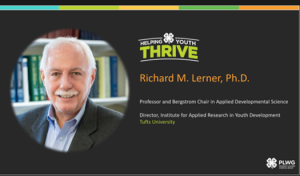
Dr. Richard M. Lerner
Bergstrom Chair of Applied Developmental Science and Director of the Institute for Applied Developmental Research, Tufts University
Recording
4-H Panel Response

Recording
Breakout Sessions
The Essential Elements of PYD
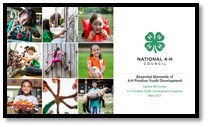
Recording
The Science Behind the Magic of 4-H Youth Development
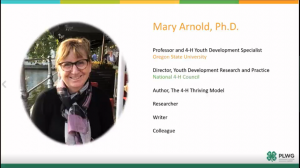
Recording
Presentation Slides (PDF)
Measuring the Impact of 4-H

Recording
Presentation Slides (PDF)
Growing Together: 4-H Professional, Research, Knowledge and Competencies (PRKC)
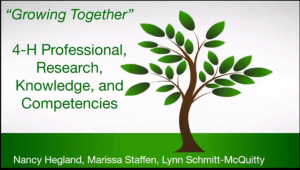
Recording
Presentation Slides (PDF)
Managed Change for Improved Program Quality
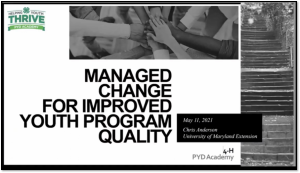
Recording
Presentation Slides (PDF)
Ensuring 4-H Program Quality – A Focus on Developmental Relationships (Day 2)
Keynote Address – Developmental Relationships: The Roots of Resilience and Thriving
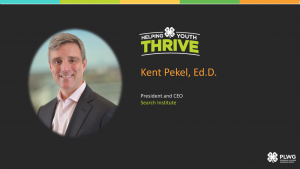
Dr. Kent Pekel
President and CEO, Search Institute
Recording
4-H Panel Response
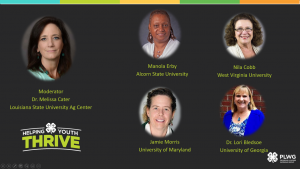
Recording
Breakout Sessions
Working with Volunteers to Achieve Inclusion and Belonging

Community Connections: Helping Military Kids Belong and Thrive through Volunteer Engagement
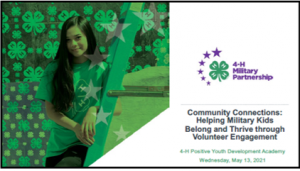
Professional Development of the 4-H Thriving Model
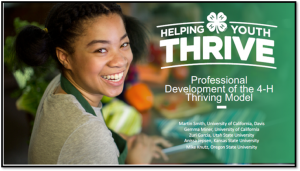
Five Principles to Guide Diversity Equity & Inclusion Work
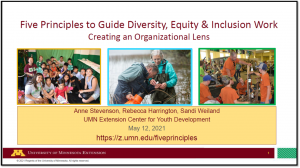
Using the 4-H Thriving Model in Wisconsin- From Theory to Practice

Equity and Opportunity for all Youth (Day 3)
Keynote Address – Robust Equity and Transformative Experiences: Keys to Youth Thriving
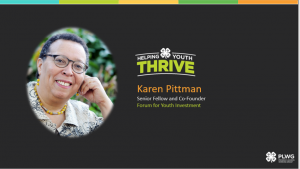
Karen Pittman
Co-Founder and Senior Fellow, The Forum for Youth Investment
Recording
4-H Panel Response

Recording
Breakout Sessions
Working with LGBTQ Youth
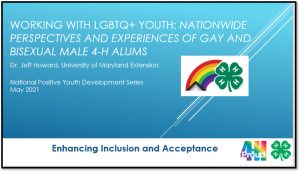
Teaching and Leading Social Justice Programs with Youth
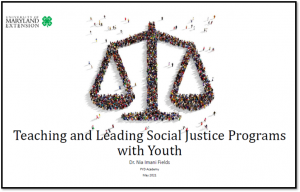
Recording
Presentation Slides (PDF)
Cultural Awareness and Equity in Extension: Focus on Volunteers
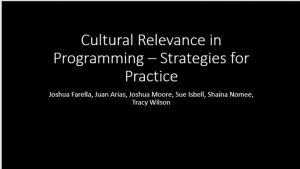
Youth in the Somali Diaspora: An Opportunity for Positive Youth Development
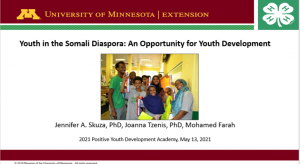
Leading Change to Address the Needs of First Generation 4-H’ers

Linkfrom Montanna-Doesn't belong here but saves the Link
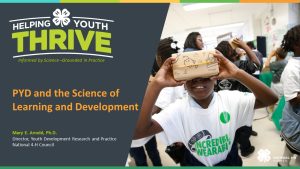 Positive Youth Development and the Science of Learning and Development
Positive Youth Development and the Science of Learning and Development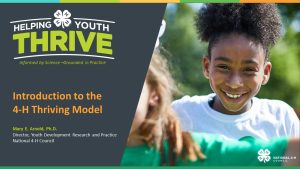 An Introduction to the 4-H Thriving Model
An Introduction to the 4-H Thriving Model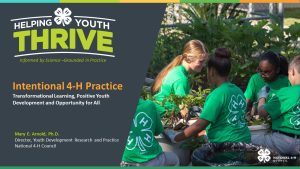 Informed by Science – Grounded in Practice
Informed by Science – Grounded in Practice

